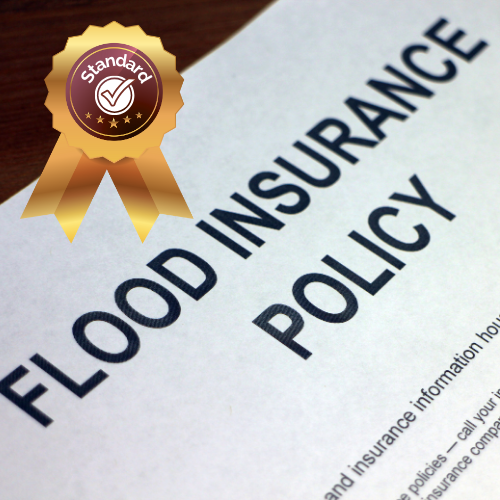The Standard Flood Insurance Policy

A Model of Consistency
Flood Insurance Fundamentals: Part 1 starts with understanding that the Standard Flood Insurance Policy (SFIP) is a single peril insurance policy available to property owners in participating communities to purchase flood insurance as protection against flood losses
What is a Flood?
The Standard Flood Insurance Policy defines a flood as:
- A general and temporary condition of partial or complete inundation of two or more acres of normally dry land area or two or more properties from:
- Overflow or inland or tidal waters
- Unusual and rapid accumulation or runoff of surface water from any source
- Mudflow
Mudflow is Defined As
- A river or liquid and flowing mud on the surface of normally dry land areas as when earth is carried by a current of water
- Mudflow is not:
- Landslides
- Slope failure
- Saturated soil mass
- Mudflow is not:
Who Has a Flood Risk?

Where it Rains, It Can Flood
All property owners in all flood zones have a flood risk. However, some areas have more risk of flooding than others
Special Flood Hazard Areas
Special Flood Hazard Areas: A land area that will be inundated by a flood event having a 1% annual chance of being equaled or exceeded in any given year
Commonly referred to as the “base flood” or “100-year flood” because there is a 1% annual chance of flooding. Over a 30-year mortgage the likelihood grows from 1% to at least 26%
SFHAs are identified on Flood Insurance Rate Maps (FIRMs) issued by FEMA and are subject to mandatory flood insurance purchase requirements under the National Flood Insurance Program (NFIP)
SFHAs include zones designated with letters such as A, AO, AE, AH, A99, AR, V, VO, and VE, which represent varying levels of flood risk and types of flooding
Non-Special Flood Hazard Areas
Non-Special Flood Hazard Areas (NSFHAs): Areas with a moderate-to-low risk of flooding. These areas are located outside the 1% annual chance floodplain
- NSFHAs are identified on FEMA’s Flood Insurance Rate Maps (FIRMs) with the following zone designations:
- Zone B (shaded): Moderate flood hazard areas between the limits of the base flood and the 0.2% annual chance (500-year) flood.
- Zone C (unshaded): Minimal flood hazard areas outside the limits of the 0.2% annual chance flood.
- Zone X:
- Shaded: Moderate flood hazard areas, similar to Zone B.
- Unshaded: Minimal flood hazard areas, similar to Zone C
- Zone D: Represents areas where flood hazards are possible but undetermined, meaning no detailed flood hazard analysis has been conducted for these locations
Flood insurance is not federally required in NSFHAs but is recommended as flooding can still occur in these zones
Note: 40% of NFIP claims come from properties in NSFHAs
What is the Flood Insurance Rate Map (FIRM)?
An official map created by the Federal Emergency Management Agency (FEMA) that identifies flood hazard areas and associated risk zones within a community
FIRMs are available to the public and can be accessed through the FEMA Flood Map Service Center: https://msc.fema.gov/portal/home
Who Can Buy NFIP Flood Insurance?

Lets Find Out
Any property owner in any flood zone in any Participating Community may purchase an NFIP flood insurance policy
What is a Participating Community?
A participating community in the National Flood Insurance Program (NFIP) is a community that has agreed to adopt and enforce FEMA-approved floodplain management regulations to reduce the risk of flooding
The Federal government makes NFIP flood insurance available to property owners, renters, and businesses within the participating community, regardless of their specific location within or outside of mapped flood hazard areas
How to
Determine if Your Community is Participating in the NFIP Program
FEMA provides the Community Status Book Report as a resource that contains the current status of communities participating in the National Flood Insurance Program (NFIP).
- The resource provides the following about communities:
- Participates in the NFIP: Indicates that the community has adopted FEMA-approved floodplain management regulations, allowing property owners to purchase NFIP flood insurance.
- Does not participate: Communities that have not joined the NFIP, making flood insurance unavailable through the program.
- Is suspended or sanctioned: Communities that were previously part of the NFIP but failed to comply with its requirements, leading to suspension or sanctions
The Community Status Book Report can be found here: https://www.fema.gov/flood-insurance/work-with-nfip/community-status-book
How is NFIP Flood Insurance Purchased?

It’s Easy
NFIP flood insurance is sold through licensed insurance agents or private insurance companies participating in the NFIP’s Write Your Own (WYO) Program, which allows these companies to issue and service NFIP policies on FEMA’s behalf
Who is Required to Purchase NFIP Flood Insurance?

Lets Find Out
The mandatory purchase of NFIP flood insurance is required for the following individuals and circumstances:
- Property Owners in Special Flood Hazard Areas (SFHAs):
- If a property is located in an SFHA (zones beginning with “A” or “V”) as identified on FEMA’s Flood Insurance Rate Maps (FIRMs), flood insurance is required as a condition of receiving:
- A federally backed mortgage or loan
- Federal financial assistance for property acquisition, construction, or repair (e.g., loans or grants from agencies like the Federal Housing Administration or Small Business Administration)
- If a property is located in an SFHA (zones beginning with “A” or “V”) as identified on FEMA’s Flood Insurance Rate Maps (FIRMs), flood insurance is required as a condition of receiving:
- Borrowers with Federally Regulated or Backed Loans:
- Federally regulated lending institutions (e.g., banks, credit unions) and government-sponsored enterprises (e.g., Fannie Mae, Freddie Mac) require borrowers to maintain flood insurance on properties located in SFHAs
- Recipients of Federal Disaster Assistance:
- Those receiving federal disaster assistance for properties in SFHAs must maintain flood insurance as a condition for future aid eligibility
What Are the Coverage Requirements?
- The required coverage amount must equal the lesser of:
- The outstanding principal balance of the loan, or
- The maximum NFIP coverage limit ($250,000 for residential buildings; $500,000 for non-residential buildings)
What is a Designated Loan?
- A designated loan is defined under the National Flood Insurance Program (NFIP) regulations as a loan that meets all of the following criteria:
- Secured by a Building or Mobile Home: The loan must be secured by improved real estate or a mobile home that is affixed to a permanent foundation.
- Located in a Special Flood Hazard Area (SFHA): The property securing the loan is located, or will be located, in an SFHA as identified by FEMA.
- Community Participation in NFIP: The community where the property is located must participate in the NFIP, making flood insurance available
For such loans, lenders are required to ensure that adequate flood insurance is in place for the term of the loan to comply with federal regulations outlined in the Flood Disaster Protection Act (FDPA) and its implementing regulations (e.g., 12 CFR Part 339)
Who Should Buy Flood Insurance?

Lets Explore the Facts
Anyone who wants to protect their property from flood damage should consider purchasing flood insurance, but certain individuals are particularly encouraged to do so:
Property Owners in High-Risk Areas (SFHAs)
- If your property is in a Special Flood Hazard Area (SFHA), and you do not have a mortgage from a federally regulated or insured lender.
- Floods are statistically more likely in these areas, and the NFIP provides coverage to help mitigate financial losses
Property Owners Outside High-Risk Areas
- Even if you live outside SFHAs, it is wise to consider flood insurance.
- FEMA reports that 40% of all flood claims come from properties outside of high risk zones.
- Flooding can occur anywhere it rains, and standard homeowners insurance does not cover flood damage
Renters
- Renters should purchase contents-only flood insurance to protect their personal belongings because their landlord’s policy will not cover these items in the event of a flood
Business Owners
- Businesses can purchase NFIP commercial policies for building and contents coverage up to $500,000 each
- This is especially important for businesses located in flood-prone areas
Homebuyers:
- If you are buying a home in a participating NFIP community, consider purchasing flood insurance at or before the time of closing,
- The 30-day waiting period does not apply is the home buyer has done this
Why NFIP Flood Insurance is Preferable to Disaster Assistance

Make Good Choices
Flood insurance is the more reliable and comprehensive option for financial recovery after a flood
- Reliability: Flood insurance provides guaranteed coverage after a qualifying flood event, while disaster assistance depends on a Presidential Disaster Declaration.
- Financial Burden: Flood insurance offers higher payouts without repayment obligations, whereas disaster assistance often involves loans with interest.
- Comprehensive Protection: Flood insurance is designed to restore properties to pre-flood conditions within policy limits; disaster assistance primarily addresses immediate safety and habitability
Disaster assistance can supplement recovery efforts but should not be relied upon as the primary source of protection
| Consider | NFIP Flood Insurance | Disaster Assistance |
|---|---|---|
| Eligibility | Available to anyone in a participating NFIP community, regardless of flood zone | Requires a Presidential Disaster Declaration, which is not guaranteed for every flood event |
| Coverage Trigger | Activated by any qualifying flood event | Only available after a federally declared disaster |
| Payout Amounts | Average claim payout is significantly higher (e.g., $29,000–$69,000) | Grants average around $5,000, with a maximum cap (e.g., $33,300 under FEMA’s Individuals and Households Program) and Loans must be repaid with interest |
| Scope of Coverage | Covers damages to buildings and contents within policy limits (up to $250,000 for residential and $500,000 for businesses) | Focuses on making homes “safe, sanitary, and functional” but does not restore them to pre-disaster condition |
| Repayment Requirements | No repayment required; policyholders pay an annual premium | Most assistance comes as loans (e.g., SBA loans) that must be repaid with interest |
| Duplication of Benefits | Insurance covers specific damages to property. Disaster assistance can cover other costs like temporary housing or medical expenses but cannot duplicate insurance payouts | Cannot duplicate insurance payouts; provides supplemental aid for uncovered costs like vehicle damage |
| Future Requirements | Continuous coverage is optional but strongly recommended for financial protection | Recipients of disaster assistance in SFHAs must purchase and maintain flood insurance for future eligibility |
How Much NFIP Insurance Can Be Purchased?

Vital Facts You Need to Know
The Building and the Contents flood Insurance are purchased separately and each have their own deductible
The NFIP operates two programs: The Emergency Program (with limited coverage) and the Regular Program (with higher coverage limits)
Coverage is available for three building types: Residential (1-4 Family), Other Residential, and Non-Residential
Coverage Limits by Building Type in the Regular Program
Residential (1-4 Family Dwellings)
- Maximum building coverage: $250,000
- Maximum contents (personal property) coverage $100,000
- This category includes single-family homes and residential units within 2-4 family unit buildings
Other Residential Buildings
- Includes multi-family residential buildings with five or more units
- Maximum building coverage: $500,000
- Maximum contents coverage: $100,000
Non-Residential/Commercial Buildings
- Includes businesses, schools, churches, and other non-residential structures
- Maximum building coverage: $500,000
- Maximum contents coverage: $500,000
Emergency vs. Regular Program
Under the Emergency Program, which applies to communities newly admitted to the NFIP, lower coverage limits are available
Residential Buildings
- Up to $35,000 for Buildings
- Up to $10,000 for Contents
Other Residential Buildings
- Up to $100,000 for Buildings
- Up to $10,000 for Contents
Non-Residential Buildings
- Up to $100,000 for Buildings
- Up to $100,000 for Contents
The Regular Program, which most participating communities adopt after completing flood hazard mapping, offers the full coverage limits previously listed above
When Does an NFIP Policy Become Effective?

It’s Time to Go Live
An NFIP flood insurance policy typically becomes effective after a 30-day waiting period from the date of purchase
The waiting period is designed to prevent individuals from purchasing coverage only when an imminent flood threat is anticipated
There are specific exceptions to the 30-day waiting period that allow policies to take effect sooner
Post-Wildfire Exception: 1 Day Wait
- If a property is at increased risk of flooding due to a wildfire that has burned on federal land, the waiting period is reduced to 1 day
- This exception applies when flooding results from post-wildfire conditions, such as debris flow or erosion
Insurance in Connection with a Loan Transaction-Making, Increasing, Renewing, or Extending (MIRE)
- If flood insurance is required as part of a loan transaction such as when making, increasing, renewing, or extending (MIRE) a loan
- The policy becomes effective immediately upon the loan closing or modification date.
- This ensures that borrowers comply with federal flood insurance requirements without delay
Insurance Purchased Within 13 months of a Map Revision: 1-Day Wait
- When a property’s flood zone designation changes due to a FEMA Flood Insurance Rate Map (FIRM) revision, property owners can purchase flood insurance with only a 1-day waiting period if the policy is purchased within 13 months of the map change.
- This exception encourages property owners to secure coverage promptly after their flood risk is reclassified



Leave a Reply